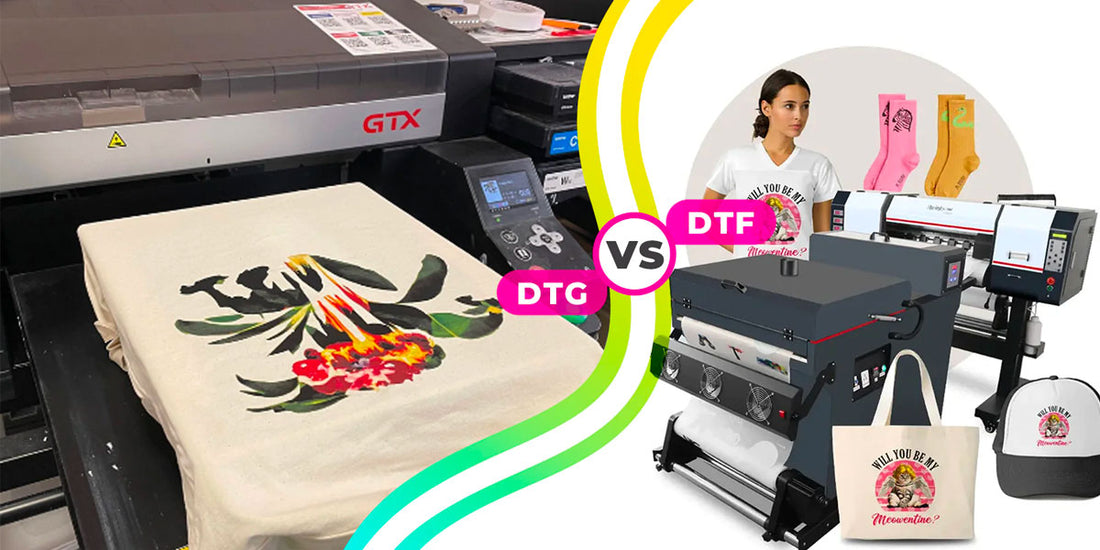Direct-to-Film (DTF) is an emerging printing process that competes with Direct-to-Garment (DTG) printing in garment customization. If you are a designer, creator, or apparel retailer, understanding the differences between these processes will help you make more money.
What is printing? Direct-to-Film (DTF) ;
Direct to film (DTF) printing is a garment customization method that prints a design onto a special film using a high-quality inkjet printer. The film is then placed onto the fabric and heat-pressed, transferring the ink to the fabric.
The main benefits of DTF are:
Versatility - Direct to film printing performs well on a range of materials such as cotton, poly-cotton blends, polyester and more.
High-quality results - DTF printing produces high-quality results similar to traditional screen printing. The designs are vivid and the print is clear.
Durability - Printed designs adhere to the fabric, making them last longer.
What is Direct-To-Garment (DTG) printing?
Direct-to-garment (DTG) printing customizes clothing by applying ink directly to the fabric. Using a specially designed inkjet printer, DTG is a popular alternative to traditional screen printing.
The main benefits of DTG are:
Highly detailed images - Complex designs with lots of colors look great.
Soft feel - Water-based inks absorb into the fabric and keep it soft.
Fewer production steps - DTG printing requires fewer steps to complete a project.
DTF vs. DTG comparison
Every project is different, so there is no one best printing method. Direct to film printing and direct to garment printing can produce great results, but we have found the following based on our experience.
Vibrancy in colors
Direct-to-film transfer prints achieve excellent color vibrancy with bold colors and accuracy. Alternatively, vibrant color was an area where Direct-To-Garment printing did not perform as well.
Resistance
Both adaptation methods can produce long-lasting prints, but DTF printing tends to produce more durable results. Direct to Film designs are bonded to the fabric using heat, while Direct to Garment coats fabric fibers that will fade over time.
Touch
Garments printed with both methods have a very good feel to the touch, but DTG produces a softer texture. The feel of a DTF printed garment will depend on many factors for a soft texture and can sometimes create a smooth, glossy finish, resembling vinyl.
Fabric types
The DTF can be used on a wide range of fabrics, including cotton, polyester, and blended fabrics, while DTG performs better on natural fiber products like cotton. It uses water-soluble ink, which is not easily absorbed by many synthetic fabrics like polyester, nylon, and rayon.
Printing speed
The production speed of DTG and DTF garment printing can vary depending on a number of factors, but Direct to Film is typically faster. The big difference is the curing time for DTG, which can take up to 15 minutes.
Ease of printing
Direct-to-Film is easier than Direct-To-Garment printing. Once the ink is printed in DTF transfer, it only needs to be pressed onto the fabric using heat. DTG printing requires the fabric to be pre-treated with chemicals before printing and then, it must be cured with heat after printing.
Flexibility
Direct-to-Film is much more flexible than Direct-to-Garment printing. Not only can DTF work on most fabrics, but it can also be applied to most types of garments. Additionally, the ability to place DTF transfers by hand allows for unique print placements that DTG cannot match.
Cost
DTF tends to be less expensive than DTG. Although both printing methods require a significant amount of equipment, additional costs such as consumables, maintenance, and staff training give DTF the edge in the cost battle.
This simplified comparison of Direct-to-Film printing with Direct-to-Garment printing is based on a broad set of assumptions.
However, results may vary depending on specific applications. Contact us to learn more about the best option for your project.
Which is the best printing method: DTF or DTG?
Direct to film (DTF) and direct to garment (DTG) printing can produce excellent results. While the best choice will depend on factors such as project requirements, garment, and budget, we recommend DTF as the best option.
It is less expensive and more flexible, while still providing a feel comparable to Direct to Garment printing.
Regardless of whether you are an individual creator or a small business, DTF printing offers significant advantages over Direct-to-Garment.

